Traditional ceramics have left an indelible mark on our daily lives and the evolution of humankind. With a history dating back millennia, ceramics have not only adorned our history with artistic figurines but also served practical purposes, such as storing grains in ceramic containers. In this article, we will take you on a journey through the historical significance of ceramics, their versatile applications, the various types, and provide insights on how to embark on the exciting journey of learning ceramics.
What exactly are ceramics?
Ceramic items are crafted by melding naturally occurring raw materials like clay, earthy minerals, and water, and then molding them into various shapes using techniques like hand-building, wheel-throwing, or mold casting. After the shaping process, these objects are subjected to high-temperature kiln firing, which bestows upon them durability and heat resistance. Ceramics serve myriad purposes, from being used in construction materials to functioning as practical dinnerware, ornate sculptures, and more.
The term “ceramic” can be employed both as an adjective and as a noun to refer to the clay object post-firing. In the realm of ceramics, numerous techniques come into play, with the choice dependent on the specific project at hand. From hand-built creations using methods like slab construction, coiling, and pinching to wheel-throwing for crafting symmetrical pottery and slip casting for producing multiples of a single item, the world of ceramics offers a diverse array of possibilities.
Exploring classic varieties of ceramic pottery
Familiar examples include earthenware, stoneware, porcelain, and bone china. Clay, as one of the abundantly accessible raw materials for crafting ceramics, forms the foundation of these diverse pottery types. The utilization of various clay types and their amalgamation with different compositions of silica and other minerals yields the rich spectrum of ceramic pottery varieties we encounter.
Earthenware
Earthenware, with its distinctive characteristics, holds a significant place in the history of ceramics. Unlike some of its more refined counterparts, earthenware is pottery that doesn’t undergo the firing process necessary for vitrification. Vitrification involves the transformation of crystalline silicate compounds into noncrystalline glass compounds, resulting in a glass-like finish. However, earthenware retains a certain porous quality and coarser texture due to its lower firing temperature, which distinguishes it from other ceramic types.
This form of pottery, prominently used in households and daily life, enjoyed widespread popularity until the 18th century. One of the most familiar varieties of earthenware is terracotta, a clay-based and unglazed ceramic. Terracotta’s natural earthy hues and rustic charm make it an enduring choice for various applications.
In contemporary times, you can still find earthenware’s influence in our surroundings. Terracotta planters, with their natural aesthetic and excellent breathability for plant roots, have become a staple in gardens and home decor. Additionally, earthenware’s durability and heat resistance have led to its use in the construction industry, where bricks and water pipes made from this material stand the test of time.
The legacy of earthenware continues to shape our world, connecting us to the craftsmanship and practicality of bygone eras while remaining relevant in today’s modern landscape.
Stoneware
Stoneware, with its unique properties, is a remarkable ceramic form that has garnered a special place among pottery enthusiasts. What sets stoneware apart from other ceramics is its vitreous or semi-vitreous nature. This means that stoneware is coated with enamel, giving it a glassy finish and making it nonporous. This characteristic is particularly advantageous, as it renders stoneware highly durable and resistant to the absorption of liquids, making it ideal for a range of applications.
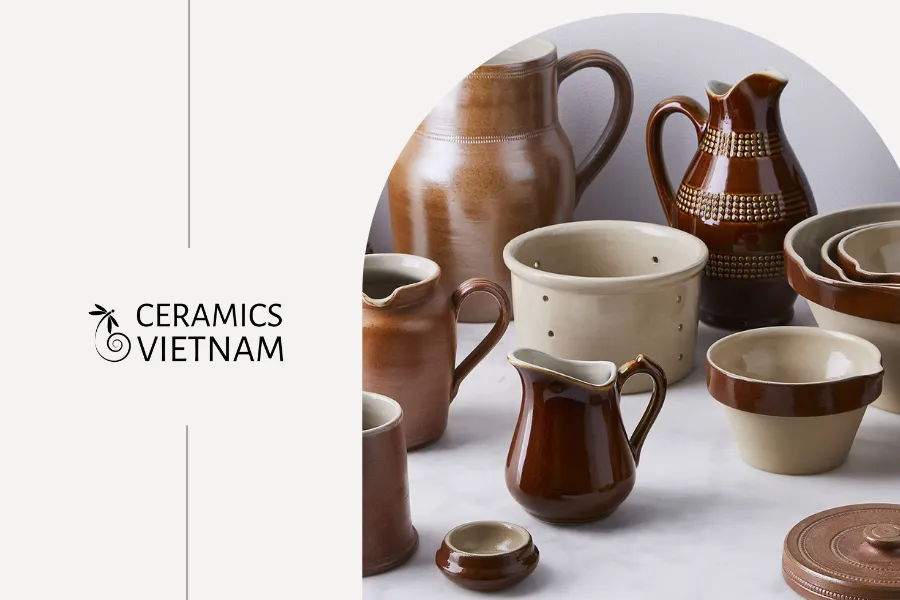
Stoneware pieces often exhibit earthy tones, which are a result of the impurities present in the clay
One distinguishing feature of stoneware is the firing process it undergoes. Stoneware is fired at notably high temperatures compared to other ceramics, typically reaching temperatures of around 2,200 to 2,400 degrees Fahrenheit (1,200 to 1,300 degrees Celsius). This intense heat results in the fusion of clay and glaze, creating a solid and robust piece of pottery that can withstand the rigors of everyday use.
Stoneware pieces often exhibit earthy tones, which are a result of the impurities present in the clay. These natural colors contribute to stoneware’s organic and rustic appearance, making it a favorite among both potters and those who appreciate ceramic art. Additionally, stoneware is typically glazed, not only to enhance its aesthetic appeal but also to further enhance its nonporous properties.
The versatility and resilience of stoneware have made it a preferred choice for crafting various items, such as functional dinnerware, kitchenware, and artistic pottery. The elegant fusion of aesthetics and functionality in stoneware pieces continues to captivate art enthusiasts and everyday users alike, highlighting its enduring appeal in the world of ceramics.
Porcelain
Porcelain, often referred to as “white gold,” is a form of ceramics celebrated for its exquisite beauty, exceptional strength, and remarkable heat resistance. The creation of porcelain involves a meticulous and high-temperature process that transforms it into a coveted material for both practical and artistic endeavors.
The primary raw material used in the production of porcelain is kaolin clay, which is known for its purity and fine particle size. This clay, when mixed with other raw materials, is carefully heated in a kiln to temperatures that range between 2,200 and 2,600 degrees Fahrenheit (1,200 to 1,430 degrees Celsius). It’s this high-temperature firing process that distinguishes porcelain from other ceramics.
The result of this intense heat is the vitrification of the clay, transforming it into a dense, nonporous, and translucent material. During the firing, a silicate mineral called mullite is formed, which further contributes to porcelain’s strength and heat resistance. These unique properties make porcelain an ideal choice for various applications, where durability and aesthetic appeal are essential.
Common uses of porcelain ceramics span a broad spectrum. It’s frequently employed in crafting elegant bathroom and kitchen tiles, where its nonporous nature and resilience shine. Porcelain vessels, both functional and decorative, exemplify the marriage of utility and artistry. Moreover, porcelain is often the medium of choice for creating intricate decorative sculptures that adorn homes, galleries, and public spaces.
The enduring allure of porcelain lies in its ability to seamlessly blend practicality and beauty. It continues to be cherished for its timeless elegance and versatility, transcending centuries and captivating both artists and consumers with its refined aesthetic and enduring quality.
Bone china
Bone china, often referred to as fine china, stands as a testament to the elegance and craftsmanship of the ceramic world. Renowned for its exceptional translucency, remarkable strength, and resistance to chipping, bone china has secured its place as a prestigious choice in the realm of porcelain ceramics.
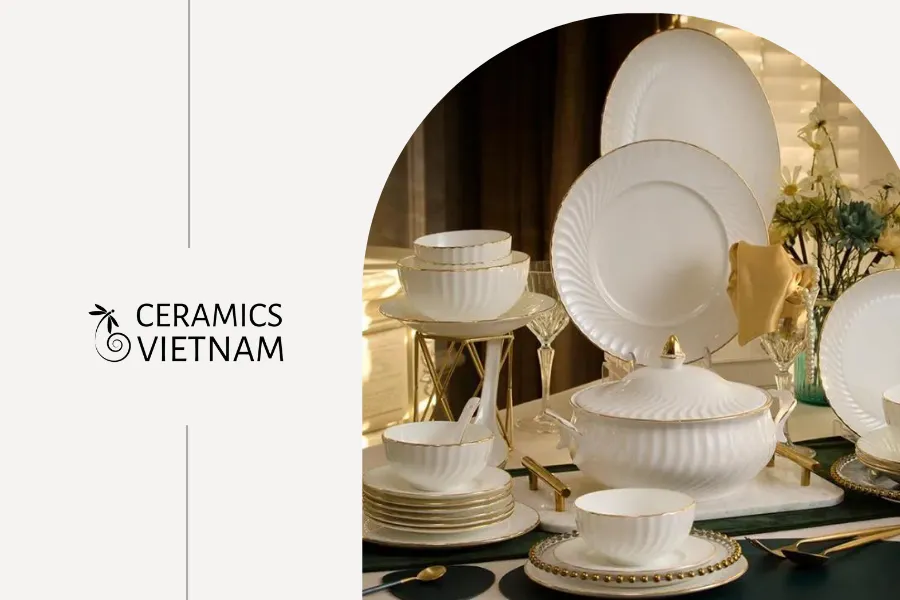
Bone china, often referred to as fine china, stands as a testament to the elegance and craftsmanship of the ceramic world
The distinctiveness of bone china arises from its unique composition, a blend of bone ash, feldspathic material, and kaolin. It was the inventive work of English ceramicist Josiah Spode around 1800 that brought this exquisite material into being. The inclusion of bone ash contributes to the extraordinary strength of bone china, allowing artisans to create delicate and thin forms that are often unattainable with traditional porcelain.
The vitrification process employed during firing renders bone china nonporous and imparts a glossy finish, adding to its aesthetic appeal. Yet, what truly sets bone china apart is its inherent translucency, which is a result of distinct mineral properties within the material. When held to the light, bone china exudes a captivating glow, making it a preferred choice for crafting delicate teacups, saucers, and other fine tableware.
Bone china’s timeless elegance and unparalleled refinement have made it a symbol of sophistication and grace in the world of ceramics. Whether gracing an elaborate dining table or cherished as collectible heirlooms, these exquisite pieces are a testament to the enduring craftsmanship and artistic excellence of bone china artisans.
The Journey of Ceramics: A Historical Odyssey
Ceramics, an ancient art form with a history spanning millennia, holds a profound significance in the tapestry of human culture. This historical odyssey of ceramics has witnessed remarkable developments, innovations, and adaptations. Let’s embark on a voyage through time to explore the remarkable journey of ceramics.
The oldest known ceramics
Our journey begins with the oldest known ceramics, which trace back to at least 25,000 BC. Discovered in Czechoslovakia, these ancient ceramics took the form of intricate animal and human figurines. Crafted using a mixture of animal fat, bone, bone ash, and clay, these early artifacts were fired in ground kilns or left in the sun to naturally harden, showcasing the resourcefulness of our ancestors.
First functional ceramic vessels
Around 9,000 BC, a significant milestone was reached with the creation of the first functional ceramic vessels. These ceramics served practical purposes, primarily for storing food, grains, and water. This period also witnessed the emergence of small farming communities in Asia, the Middle East, and Europe, where these utilitarian ceramics played a pivotal role.
Decorative glazes and surface design
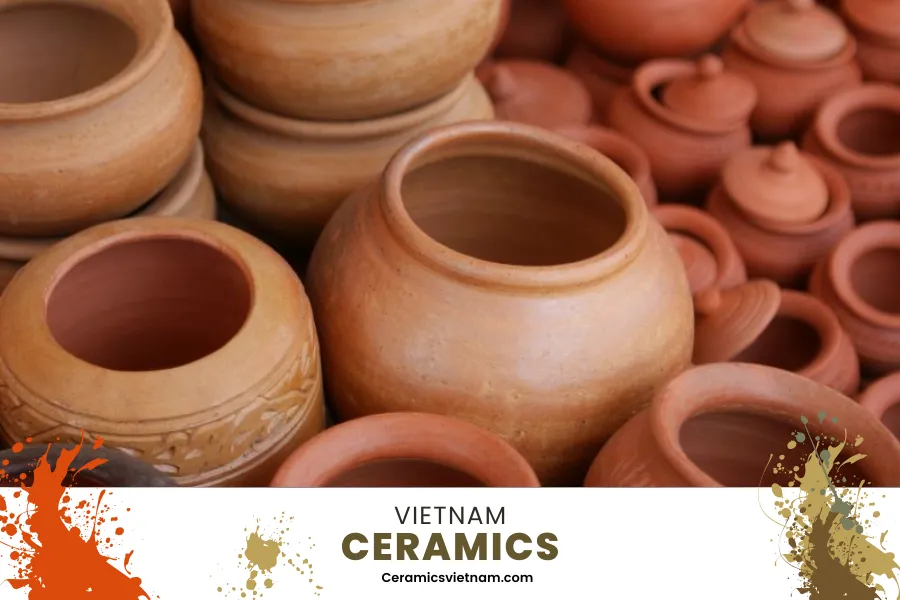
Early ceramics featured simplicity in their design and texture and were generally fired without glazes
Early ceramics featured simplicity in their design and texture and were generally fired without glazes. However, a transformative moment in ceramic history arrived during the 6th and 5th centuries BC, as Greek Attic vases introduced the innovative use of oxidizing and reducing atmospheres during firing. This technique unlocked the potential for creating intricate surface patterns and varying colors, ushering in a new era of artistic expression through ceramics.
The invention of the wheel
In 3,500 BC, the invention of the potter’s wheel marked a significant breakthrough in ceramic production. This ingenious device allowed potters to transcend the limitations of hand-building and ushered in an era of creating ceramic pieces with radial symmetry. The wheel not only increased efficiency but also enriched the diversity of ceramic forms.
The introduction of porcelain
Around 600 CE, Chinese potters achieved a monumental milestone by introducing high-temperature kilns and developing porcelain from kaolin clay, also known as China clay. This groundbreaking development revolutionized ceramics by producing less porous and much stronger vessels. Although low-fire earthenware dominated Europe and the Middle East until the Middle Ages, the advent of the Silk Road facilitated the trade of porcelain and high-temperature kiln technology, spreading their influence throughout Islamic countries and Europe.
Modern-day ceramics
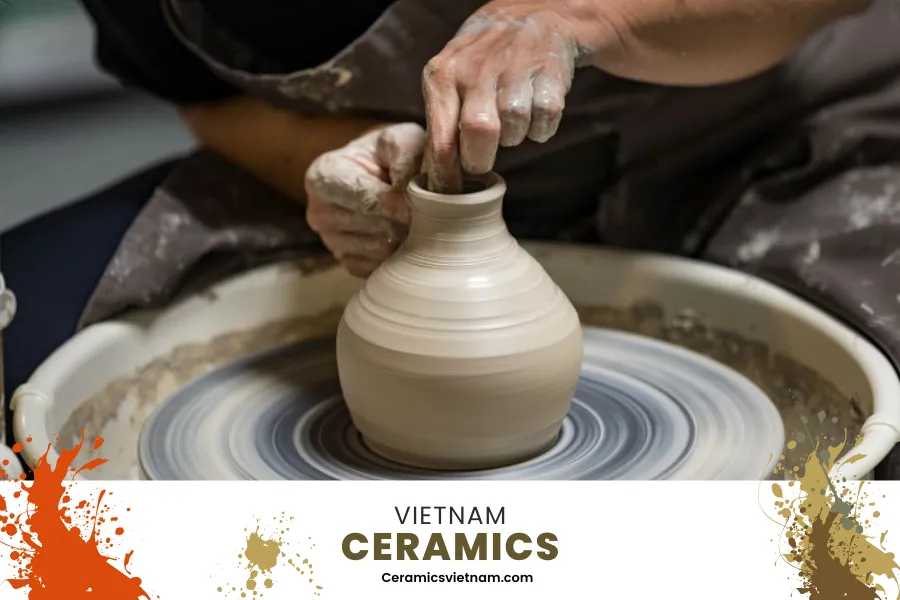
In the modern era, the ceramic industry has undergone a remarkable transformation
In the modern era, the ceramic industry has undergone a remarkable transformation. Following World War II, ceramics played a pivotal role in the advancement of technology, electronics, medical equipment, transportation, and various other fields. Today, ceramics remain as vibrant as ever, offering opportunities for individuals to explore this ancient art form for both artistic and practical purposes.
The journey of ceramics, spanning from its humble origins to its pivotal role in contemporary society, stands as a testament to the enduring allure of this timeless art form. It continues to captivate our imagination, serve our needs, and inspire creativity across the ages.
Exploring the versatility of ceramic materials
Ceramic materials, known for their wide-ranging utility, are ubiquitous in our everyday lives, demonstrating remarkable versatility and adaptability across various applications. Here, we delve into the intricacies of these ceramic types and their specific roles:
Tile
Ceramic and porcelain tiles are familiar sights in homes and commercial spaces. Ceramic tiles are primarily composed of silica, minerals, and clay. Shaped and fired in kilns, these tiles exhibit distinct characteristics. They differ from porcelain in their composition and firing process. Ceramic tiles incorporate a blend of coarser clay with a lower kaolin clay ratio and are fired at lower temperatures, typically below 1,650 degrees Fahrenheit.
The differences extend to density and porosity. Ceramic tiles, being less dense, are more prone to cracking and breakage, making them ideal for areas with less foot traffic. However, their inherent porosity makes them susceptible to water infiltration, limiting their use in wet areas. On the other hand, porcelain tiles, with their denser structure, are highly durable, water-resistant, and suited for both indoor and outdoor applications.
Glass ceramic
Ceramic glass is a marvel of engineering, boasting impressive mechanical strength and resistance to thermal shock. This unique combination of qualities makes it an ideal choice for cooktops and cookware. It can endure rapid temperature fluctuations without shattering and remains impermeable, making it easy to clean. Beyond the kitchen, ceramic glass extends its utility to engineering components, thermal insulation, and telescopic mirrors, showcasing its adaptability in various domains.
Brick
Bricks, one of the oldest construction materials, remain indispensable for building structures. They are crafted by blending clay with water, shaping the bricks, and subsequently drying and firing them. Bricks serve as fundamental building blocks for walls, chimneys, fireplaces, and more. Their enduring popularity is a testament to their durability and insulating properties.
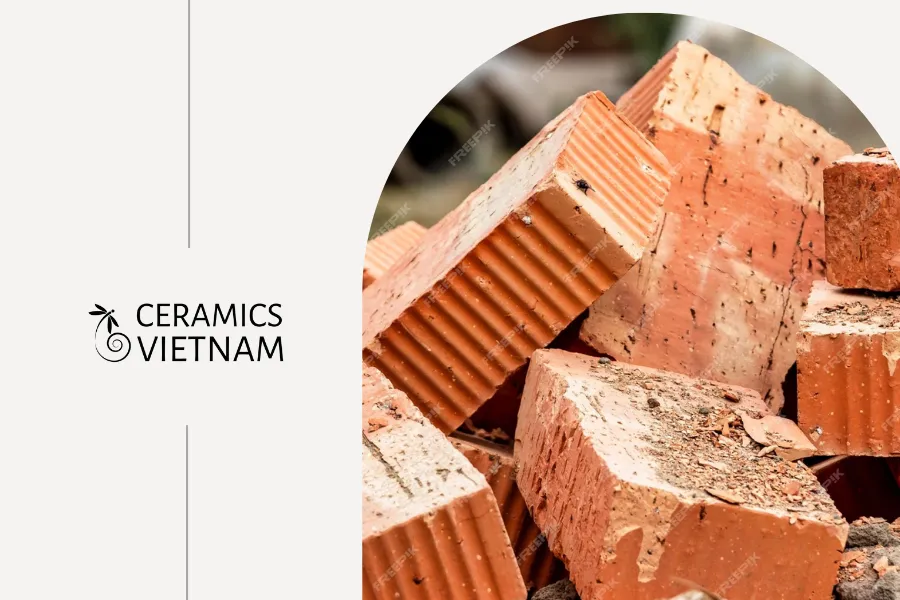
Bricks, one of the oldest construction materials, remain indispensable for building structures
Silicon
Silicon, a naturally abundant material, plays a pivotal role in diverse ceramic applications. It is a versatile component in the creation of an array of ceramic products, contributing to their strength, insulation, and electrical properties. Silicon’s prevalence in ceramics underscores its significance in the field.
Carbide
Carbide ceramics are celebrated for their exceptional resistance to heat, abrasion, and corrosion. This category encompasses several materials, including silicon carbide, titanium carbide, and tungsten carbide. These ceramics find applications in mechanical engineering, chemical industries, power engineering, microelectronics, and space exploration.
Silicon Carbide: Known for its outstanding hardness, silicon carbide is employed in manufacturing cutting tools, grinding wheels, and abrasion-resistant parts.
Titanium Carbide: This carbide is vital in the creation of cutting tools and wear-resistant coatings.
Tungsten Carbide: With its exceptional toughness, tungsten carbide is used for producing cutting tools, jewelry, and abrasion-resistant products.
The diverse range of ceramic materials underscores their ubiquity in our lives. They cater to numerous aspects of science, technology, and daily living, providing durability, functionality, and aesthetic appeal across a wide array of applications. These ceramics, with their distinct properties, continue to be an integral part of human innovation and progress.
FAQs
- What is the cone system used to measure kiln firing temperatures?
The cone system is a critical tool for assessing kiln firing temperatures and ensuring that the process is carried out correctly. Cones are integral when firing ceramics, helping gauge the kiln’s heat levels and the duration for which the clay body is exposed to the heat. Each cone is designated by a specific number corresponding to a defined temperature range. For instance, cone 03 indicates a temperature range of approximately 1960 to 1987 degrees Fahrenheit.
Cones are strategically positioned within the kiln during the firing process to absorb heat. As they approach the desired temperature, the tip of the cone begins to bend, providing a visual indicator. By observing the cones through the kiln’s window, you can ascertain whether the kiln is heating uniformly and reaching the required temperature.
- What does it mean if clay or glaze is low, mid, or high fire?
The terms “low fire,” “mid-fire,” and “high fire” refer to the temperature ranges at which clay and glazes are fired in a kiln.
- Low Fire Clay: This type of clay is fired at temperatures ranging from 1940 to 2109 degrees Fahrenheit. It is relatively easy and economical to fire, but it tends to be porous and is not the best choice for creating liquid-bearing vessels.
- Mid-Fire Clay: Mid-fire clay is fired within the range of 2157 to 2232 degrees Fahrenheit, making it suitable for electric kilns. It is known for its versatility, becoming sturdy once fired, and is non-porous.
- High Fire Clay: High fire clay is fired at approximately 2381 degrees Fahrenheit. It is durable and waterproof, making it a long-lasting and robust option. However, high fire clay is typically fired in a gas kiln, which can limit accessibility for many potters.
- What are reduction and oxidation, and what do they do?
Oxidation and reduction are terms used to describe the oxygen levels present in the kiln environment during the firing process.
- Oxidation: An oxidized atmosphere is rich in oxygen. This environment can affect the texture and color of your clay and interact with specific glazes, resulting in particular surface characteristics.
- Reduction: In a reduced atmosphere, there is a limited presence of oxygen. This environment can also influence the texture and color of the clay and can produce unique glaze effects.
- What is the difference between using a gas kiln and an electric kiln?
Gas kilns and electric kilns differ in various aspects, impacting their suitability for different clay types and firing processes.
- Electric Kilns: Electric kilns are more commonly used in both home and professional studios due to their ease of convenience and setup. They are well-suited for firing low and mid-fire clay. Electric kilns are favored for not requiring special permits. The resulting colors from electric kiln firings tend to be earthier in tone, and they can be used for reduction firings to achieve intriguing surface textures.
- Gas Kilns: Gas kilns are typically employed for high-fire clay due to their ability to reach the necessary high temperatures. They often require specialized permits due to safety concerns. Gas firings tend to produce different color characteristics compared to electric kilns, making them appealing for specific artistic effects.
- What are the safety concerns for using clay? Can I use it safely at home?
Working with clay involves several safety considerations, especially when handling clay in powdered form. Dried clay can release fine particles that contain silica, which can remain suspended in the air for extended periods and pose a risk to respiratory health.
To ensure safety, it is crucial to take the following precautions:
- Wear a Mask: Always wear a protective mask to prevent inhalation of clay particles.
- Know Your Clay: Familiarize yourself with the ingredients and composition of the clay you are using.
- Use Wet Clay Bodies: Whenever possible, opt for premixed, wet clay bodies, which are less likely to generate airborne particles. These can enhance safety when working with clay at home.
By following these safety measures, you can enjoy working with clay safely, even in a home environment.
Read more














Leave a reply